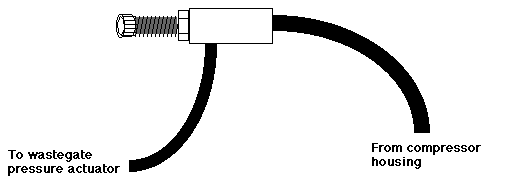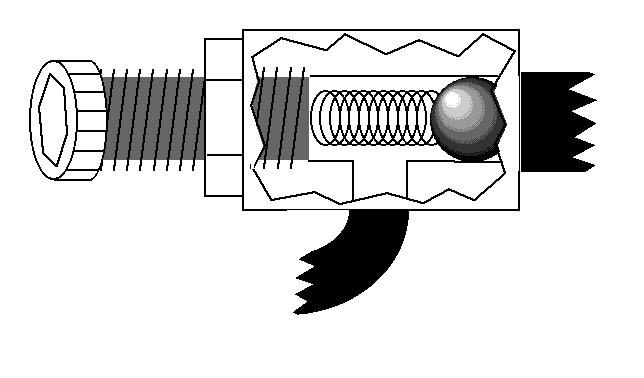Playing With Boost

A typical manual boost controller
Overview: Fast and cheap, an uncommon combination
Want to make your 22R-TE go faster? Sure you do; that's why your here. Want to make it go noticeably faster for less than $100? Well, increasing the amount of boost (technically, fooling the wastegate to open at a higher-than-stock boost pressure) is a cheap and easy way to add real, usable power to your 22R-TE's output. Like all good things, however, boost is best in moderation: too much boost will cause your engine to detonate itself to death.
The parts involved
Turbochargers are exhaust driven fans, designed to compress the air coming into the engine so that more air, and thus more fuel, can be packed into each cylinder, increasing performance. Without some means to regulate this compression, boost would continue to rise as engine RPMs increased. This wouldn't be bad, per se, if automotive engines ran on something with more purity (i.e., a higher octane) than pump gasoline. Unfortunately, we live in the real world, and the grim reality is that the more you compress a mixture of low octane fuel and air, the more likely it is going to pre-ignite. Consequently, engine manufacturers like Toyota build a lot of "margin" into their designs, so that engines like the 22R-TE will run on 86 octane crud if they need to.
The mechanism for regulating boost pressure is called a wastegate. There are two general types of wastegates: external and internal. External wastegates usually rely on adjustable springs to control their tension, and they are the mechanism of choice for high boost applications, as they are capable of controlling greater boost pressures, with more accuracy, than their internal counterparts. The 22R-TE does NOT use an external wastegate in its stock form. Instead, it uses a small internal flap connected via a lever and pushrod to a pressure actuator. When the internal pressure rises above 7.5 psi (or so; there's a lot of slop in the stock mechanism) this flap opens, and excess pressure is vented straight to the exhaust side of the turbo.
The pressure actuator takes its reading directly from the from turbocharger's compressor housing, via a small piece of tubing. You can raise the wastegate's activation pressure by "fooling" this actuator into thinking it's seeing 7.5 psi when in fact it's seeing more than that.. This trick can be performed with a manual "bleeder" valve, which is the cheapest method, or with an electronic version of the "bleeder" valve, which can run into the hundreds of dollars ($500+ is quite common).
The electronic boost controllers are very popular amongst the import performance magazine crowd, and with good reason: electronic controllers offer more precise boost regulation than their mechanical counterparts, a critical factor if you're running 20+ pounds of boost. Their precision is due to their ability to snap open the wastegate when the boost pressure reaches an *exact* maximum, whereas even the best manual boost controllers allow some amount of pressure creep as the system approaches maximum boost. If you want to explore these more expensive electronic boost controllers, I suggest picking up an issue of Turbo & Hi Tech Performance magazine; they usually have feature stories on these sorts of components.
Manual boost controllers, while a little sloppier, are considerably cheaper, and seem to me to make more sense for a truck application like the 22R-TE. Most of these boost controllers operate on the same principle: The stock pressure actuator has a preset trigger threshold, which is 7.5 psi in the 22R-TE's case. A greater amount of resistance -- let's say 15 psi -- is dialed into the controller. As the turbo builds boost, the intake tract sees a different level than the wastegate's pressure actuator. For example, if the intake tract is seeing 8 psi of boost, the sensing circuit may only be seeing 4 psi (the curve isn't necessarily linear, but we'll keep the example simple). When enough boost has developed to overcome the tensioning mechanism within the boost controller, the stock actuator sees the 7.5 psi it was waiting for, and the wastegate is opened. Simple? Yes, but...
Danger! Warning! Danger! Warning!
If this process were completely painless and worry free, Toyota probably would have shipped the 22R-TE with more boost from the factory. There ARE a few pitfalls to raising your boost levels, and it's probably worth a few lines to explain them so no one has any unpleasant surprises.
First, you should not make any significant changes to your engine's boost unless you have increased the flow into and out of the engine. This is important, because more boost means more stuff moving into and through the engine. All this extra air has got to come from somewhere and go somewhere, so if you're trying to do this with the stock intake and exhaust tract components in place, you're going to be fighting the performance battle on three fronts instead of just one. "Low restriction" should be your mantra for the intake and exhaust systems.
But wait, there's more: a lean engine is a dead engine, and it's very easy to create an ultra lean condition with more boost. This is especially true on Toyotas, as the stock mass air sensor is not all that responsive (not to mention restrictive), and the stock injectors are not all that powerful when compared with the potential of the engine. It's a silent danger: your truck will likely run GREAT, up to the point when the pistons melt. This is because maximum performance is found right on that thin edge, when just the right amount of fuel is being metered into your engine. Performance declines in a shallow arc from this point. You can walk along the cliff if you want to, but I'd rather take a few steps back from the edge. So adequate fuel delivery is just as important as the ability to move air into and through the engine. Make sure your injectors are clean and working, your fuel filter isn't clogged, and be prepared to tweak your mass air sensor a couple of clicks richer.
All of which brings up an important point: Do not attempt ANY changes to your engine's boost pressure without an accurate boost gauge. Period. Similarly, consider adding an air/fuel ratio meter, like the Halmeter AF30. Although these are a little pricey, saving your engine from disaster *once* more than makes up for the cost of the unit.
Finally, keep in mind that your engine is a collection of many components, and they all work together to generate power. Like the old adage about the chain only being as strong as its weakest link, the performance potential of your engine is determined by the combination of components you assemble. Radically tweaking just one of these will rarely do more than hobble the engine. Once you ask the motor to do more than the factory set it up to do, you have to take responsibility for your actions, and make sure that all of the bases are covered: the engine needs adequate fuel, air and spark to run, and it will demand more of each of these if you crank up the boost.
Making tracks
OK. We've talked about how boost works, and what you should do before you alter your stock boost. Let's get down to the business of playing with boost.
There are several different mechanical boost controllers on the market (as well as some DIY plans floating out there). The one I use looks like this, and is distributed by Buschur Racing:

Internally, it looks like this:

Now, I believe this is a patented design, so in the unlikely event you decide to make one of your own from this drawing, don't.
Hooking up the boost controller is remarkably simple: remove the small hose that runs from the turbocharger's compressor housing to the wastegate pressure actuator. Attach the "inlet" side of the boost controller to the compressor housing, while attaching the other end to the wastegate pressure actuator. I used a zip tie to attach the unit to a spot where I could reach it easily, but it doesn't really matter how you mount it, as long as you make sure that the adjustment end is easy to reach.
Adjusting the controller, by the way, is as easy as mounting it: turn the adjustment bolt in for a greater wastegate actuation pressure, out for less. Be cautious, because a little movement on this bolt can translate into big changes in boost pressure.
I'm currently running about 13 psi of boost; I'm a little worried that more boost would overwhelm the stock injectors, but this amount of boost provides some great performance. As you adjust your own boost, use your head, and don't let your reach exceed your grasp.
Some URLs for the do-it-yourself crowd:
http://www.eb.uah.edu/~morgan/z/board/archives/139.html
http://www.infoclypse.com/kazin/cars/boostcontrol.html
http://www.dsm.org/how-tos/JFM/Boost.html
http://rx7.miamisci.org/howtoboostcontrol.html